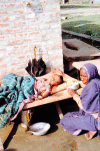The Global Enteric Multicenter Study (GEMS): impetus, rationale, and genesis
- PMID: 23169934
- PMCID: PMC3502311
- DOI: 10.1093/cid/cis761
The Global Enteric Multicenter Study (GEMS): impetus, rationale, and genesis
Abstract
Diarrheal disease remains one of the top 2 causes of young child mortality in the developing world. Whereas improvements in water/sanitation infrastructure and hygiene can diminish transmission of enteric pathogens, vaccines can also hasten the decline of diarrheal disease morbidity and mortality. From 1980 through approximately 2004, various case/control and small cohort studies were undertaken to address the etiology of pediatric diarrhea in developing countries. Many studies had methodological limitations and came to divergent conclusions, making it difficult to prioritize the relative importance of different pathogens. Consequently, in the first years of the millennium there was no consensus on what diarrheal disease vaccines should be developed or implemented; however, there was consensus on the need for a well-designed study to obtain information on the etiology and burden of more severe forms of diarrheal disease to guide global investment and implementation decisions. Accordingly, the Global Enteric Multicenter Study (GEMS) was designed to overcome drawbacks of earlier studies and determine the etiology and population-based burden of pediatric diarrheal disease. GEMS, which includes one of the largest case/control studies of an infectious disease syndrome ever undertaken (target approximately 12,600 analyzable cases and 12,600 controls), was rolled out in 4 sites in sub-Saharan Africa (Gambia, Kenya, Mali, Mozambique) and 3 in South Asia (Bangladesh, India, Pakistan), with each site linked to a population under demographic surveillance (total approximately 467,000 child years of observation among children <5 years of age). GEMS data will guide investment and help prioritize strategies to mitigate the morbidity and mortality of pediatric diarrheal disease.
Figures



References
-
- Geneva, Switzerland: United Nations; 2002. United Nations Conference on Trade and Development Secretariat. The least developed countries report 2002.
-
- United Nations Children's Fund. New York, NY: UNICEF; 2000. State of the World's Children 2000.
-
- United Nations Children's Fund. New York, NY: UNICEF; 2002. State of the world's children 2002. Leadership.
-
- Bryce J, Boschi-Pinto C, Shibuya K, Black RE. WHO estimates of the causes of death in children. Lancet. 2005;365:1147–52. - PubMed
-
- Black RE, Cousens S, Johnson HL, et al. Global, regional, and national causes of child mortality in 2008: a systematic analysis. Lancet. 2010;375:1969–87. - PubMed
Publication types
MeSH terms
LinkOut - more resources
Full Text Sources
Other Literature Sources
Medical
Molecular Biology Databases

